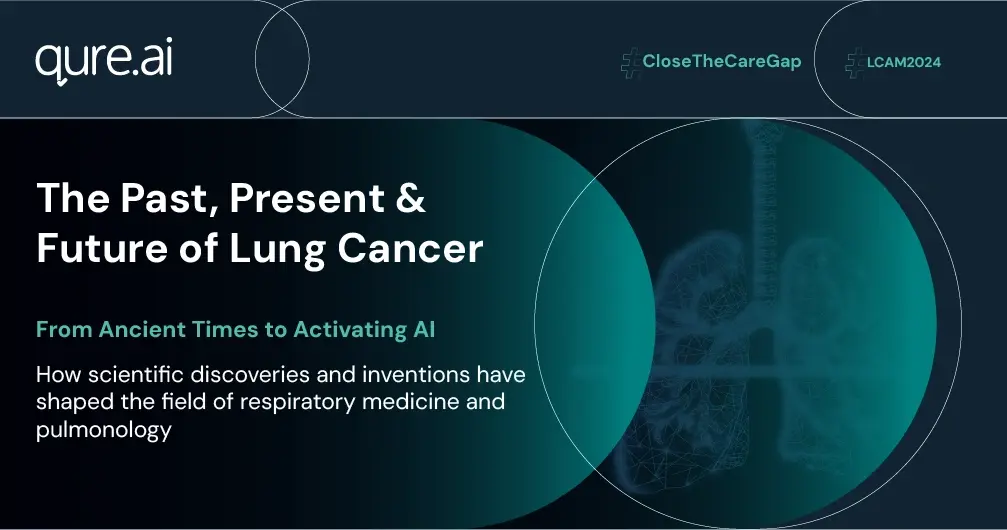From Ancient Times to Activating AI: How scientific discoveries and inventions have shaped the field of respiratory medicine and pulmonology
Back
From the earliest discoveries of respiratory diseases to the modern-day AI-driven innovations, the journey of lung health has been marked by significant discoveries, inventions and milestones.
Lung cancer, once considered a rare medical curiosity, has become a global health challenge. While tobacco use remains a significant risk factor, other elements such as second-hand smoking, radon, occupational hazards, pollution, and genetics also contribute to the development of lung cancer.
Innovations to understand & fight against Lung Cancer
The first historical observation of Lung Cancer was in the 1800s by Dr Laennec, a French physician, who described lesions in the lungs that were different to tuberculosis (TB). By 1823 the Lancet Journal is launched, promoting postmortems or autopsies to identify lung cancer as a separate diagnosis to TB.
In 1895, Wilhelm Roentgen pioneered the production and detection of electromagnetic radiation in a wavelength, x-radiation, to be known as X-rays. It was an achievement that earned him the inaugural Nobel Prize for Physics in 1901 and its use in medical applications soon followed shortly.
Fast forward to today, nearly 130 years since the invention of X-ray, plain film radiography is the mainstay of frontline medical imaging, with an estimated 2 billion chest X-rays alone performed per year globally.
The popularity and versatility of X-ray has stood the test of time with a number of innovations expanding its use and application to serve a wider range of patient communities across health boundaries. This includes the move from analogue to filmless and chemical free digital radiography; portability of detector plates to refashion the traditionally fixed systems onto wheels to take directly to patient bedsides or outpatient clinics; and the shrinking of X-ray solutions into easy-to-carry systems that fit into backpacks or flight cases to reach remote and rural communities.
The invention of Computed Tomography (CT) in the the late 1960s and its application into medicine in the early 1970s revolutionized medical imaging. Unlike traditional X-rays, which provide limited two-dimensional views, CT scans offered detailed cross-sectional slice images of the lungs, allowing for more precise visualization. This positioned CT as the gold standard for lung cancer screening in many developed nations, as it can detect small nodules or abnormalities, leading to earlier diagnoses and better survival rates.
Low-Dose CT is still central to proactive lung cancer screening programs in place across the world for high-risk groups such as ex or current smokers. These programs have reduced lung cancer mortality by enabling earlier identifications leading to interventions.
The timeline of testing for and tackling rates of TB
AI powering the future of early identification of disease
Today, AI is transforming the landscape of lung health identification and management using medical imaging.
AI solutions, like qXR from Qure.ai, analyze chest X-rays, detecting the risk of even the smallest nodules that could indicate early-stage cancer. X-ray-based surveillance as part of Incidental Pulmonary Nodule initiatives, also known as incidental nodule detection, are growing in strength.
AI's applications also extend beyond detection, with solutions like qCT that helps with precise qualification, comprehensive characterization and 3D visualization. Recently qCT LN Quant gained US FDA clearence to support radiologists and pulmonologists in analyzing lung nodules on non-contrast CT scans and tracking volumetric growth as part of progression monitoring.
AI is also playing a crucial role in the fight against TB. Qure.ai's qXR can detect TB on chest X-rays with high accuracy, helping to identify cases early and initiate timely treatment. AI also aids in contact tracing, predicting disease spread, and optimizing resource allocation in TB control programs.
The future of AI in TB care includes possibilities such as AI-guided personalized treatment regimens, AI-powered adherence monitoring, and AI-driven drug discovery for novel TB therapies. As we continue to battle this antiquated disease, AI offers hope for a future where TB is effectively controlled and ultimately eliminated.
The Future of AI in Lung Health Care
The developmental trajectory of lung health, from ancient times to the AI-driven present, is a testament to human resilience and innovation. As we observe the International Day of Radiology and Lung Cancer Awareness Month, we must celebrate the progress made in lung cancer care and TB detection, while recognizing the critical role of AI in shaping the future of lung health.
By harnessing the power of AI, we can accelerate early detection, improve treatment outcomes, and ultimately save lives. As we stand on the brink of a new era in lung health, let us embrace AI's potential to transform the way we prevent, identify, and treat respiratory diseases, paving the way for a healthier future for all.
